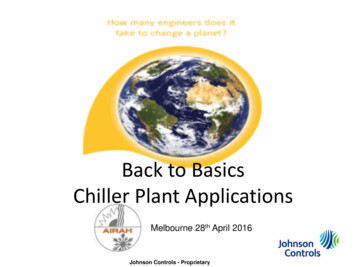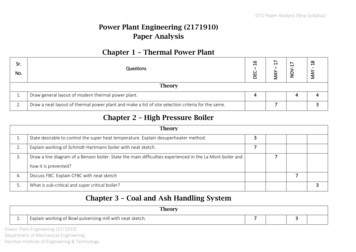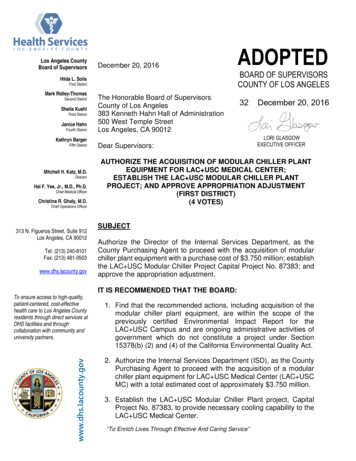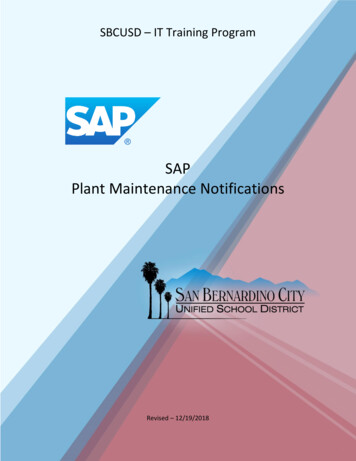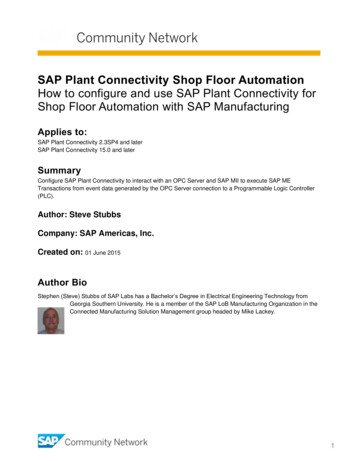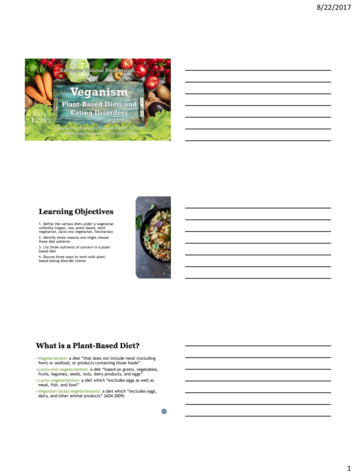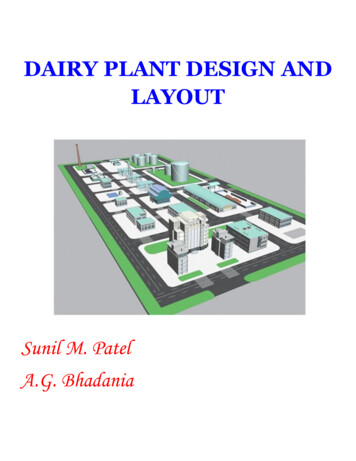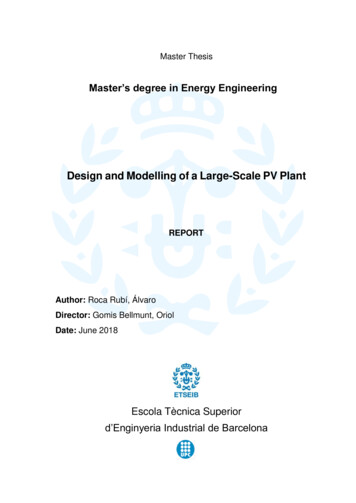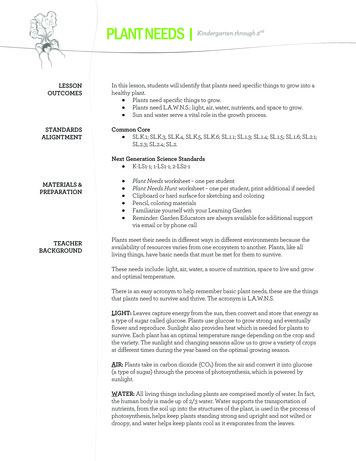
Transcription
PLANT NEEDS Kindergarten through 2ndGradeLESSONOUTCOMESSTANDARDSALIGNTMENT In this lesson, students will identify that plants need specific things to grow into ahealthy plant. Plants need specific things to grow. Plants need L.A.W.N.S.: light, air, water, nutrients, and space to grow. Sun and water serve a vital role in the growth process.Common Core SL.K.1; SL.K.3, SL.K.4, SL.K.5, SL.K.6; SL.1.1; SL.1.3; SL.1.4; SL.1.5; SL.1.6; SL.2.1;SL.2.3; SL.2.4; SL.2.Next Generation Science Standards K-LS1-1; 1-LS1-1; 2-LS2-1MATERIALS &PREPARATIONTEACHERBACKGROUND Plant Needs worksheet – one per studentPlant Needs Hunt worksheet – one per student, print additional if neededClipboard or hard surface for sketching and coloringPencil, coloring materialsFamiliarize yourself with your Learning GardenReminder: Garden Educators are always available for additional supportvia email or by phone callPlants meet their needs in different ways in different environments because theavailability of resources varies from one ecosystem to another. Plants, like allliving things, have basic needs that must be met for them to survive.These needs include: light, air, water, a source of nutrition, space to live and growand optimal temperature.There is an easy acronym to help remember basic plant needs, these are the thingsthat plants need to survive and thrive. The acronym is L.A.W.N.S.LIGHT: Leaves capture energy from the sun, then convert and store that energy asa type of sugar called glucose. Plants use glucose to grow strong and eventuallyflower and reproduce. Sunlight also provides heat which is needed for plants tosurvive. Each plant has an optimal temperature range depending on the crop andthe variety. The sunlight and changing seasons allow us to grow a variety of cropsat different times during the year based on the optimal growing season.AIR: Plants take in carbon dioxide (CO2) from the air and convert it into glucose(a type of sugar) through the process of photosynthesis, which is powered bysunlight.WATER: All living things including plants are comprised mostly of water. In fact,the human body is made up of 2/3 water. Water supports the transportation ofnutrients, from the soil up into the structures of the plant, is used in the process ofphotosynthesis, helps keep plants standing strong and upright and not wilted ordroopy, and water helps keep plants cool as it evaporates from the leaves.
PLANT NEEDS Kindergarten through 2ndGradeTEACHERBACKGROUNDCONTINUED NUTRIENTS: Plants must take up essential nutrients from the soil to supporttheir growth. These nutrients include nitrogen, phosphorus, potassium (commonlylisted as N-P-K), calcium, and magnesium. Plants also need hydrogen, oxygen, andcarbon in large quantities, they’re able to absorb those nutrients from the air andwater.SPACE: Roots and foliage take up space. Each plant has their own specific spacerequirement needs. Plants that are spaced too close together will be stressed asthey compete for their basic needs, resulting in weaker plants, highersusceptibility to diseases and insects, and ultimately poor food production.INTRODUCTIONSpend time discussing the following introductory questions: What do plants need to grow?Make a list of student responses on the board and group or categorize responsestogether, discuss and strike any responses that are not a plant need.ACTIVITYCLASSROOM ACTIVITYDuring the classroom portion of today’s lesson students will be learning about theneeds of plants using the acronym L.A.W.N.S.1.Use complete sentences and give clear directions about how the teacherwill engage with the students.2.On the white board or a large piece of paper, write the letters L.A.W.N.S.vertically and fill-in the acronym together as a class. As you move througheach letter and plant need, describe the plant need with students.LIGHT: just like we need to stay warm, plants need a warm temperature!Light keeps plants warm and helps to make food for the plants (throughphotosynthesis).AIR: just like we need air, plants need air! Air is used to make food for theplants (through photosynthesis).WATER: just like we need water, plants need water! Water helps movefood and nutrients to all the different parts of the plant.NUTRIENTS: just like we need nutrients, plants need nutrients! Nutrientsprovide plants with the strength they need to grow big, strong, andhealthy.SPACE: just like we need a place to live, plants need a place to live!Plants that have plenty of space will grow big, strong, and healthy.
PLANT NEEDS Kindergarten through 2ndGradeACTIVITYCONTINUED 3.Pass out the Plant Needs worksheet and have students complete as eithera class, in small groups, or individually.4.Review the correct answers to the Plant Needs worksheet with students:Leaves collect: light and airRoots collect: water and nutrientsBreak here if this lesson will be taught in two sections.GARDEN ACTIVITYWelcome your students to the Learning Garden and line students up along oneside of the Learning Garden. Stand on the opposite side of the Learning Garden soyou can address the entire group.Ask students if they know what they will be doing in the Learning Garden for theday’s lesson. Let them know they will be looking for evidence of plant needs beingmet!1.Use complete sentences and give clear directions about how the teacherwill engage with the students.2.Pass out the Plant Needs Hunt, remind your students of the acronym theylearned about during the classroom lesson L.A.W.N.S., and review theplant needs associated with each letter.3.Read the worksheet directions aloud and review the instructions. Practicefilling in the worksheet if needed.4.Have students complete the worksheet either as a class, in small groups,or individually. You may choose to have students complete the worksheetfor more than one plant. Print worksheets accordingly.5.Bring students back together and let students know that now they canidentify a healthy plant verses an unhealthy plant. Next, students will hearvarious scenarios and together they will find or think of things in theLearning Garden that will help the plant in the scenario.6.Read each of the scenarios aloud and look for or discuss reach of thescenarios as a classroom. Encourage hand raising.
PLANT NEEDS Kindergarten through 2ndGrade CONCLUSIONNOTE: As the teacher, be aware of poisonous plants and other hazards in andaround your Learning Garden and review those concerns with your students.Review any additional rules of the Learning Garden. Ask students about knownbee/wasp sting allergies before going into the Learning Garden.Have students share out key parts of today’s activity and review the KeyUnderstandings for this lesson.Students should clean up the Learning Garden as needed.
PLANT NEEDS Kindergarten through 2ndGradeNames:Date: PLANT NEEDSWORD BANK:LIGHTAIRWATERNUTRIENTSSPACELeaves collect:1.2.Color the leaf of the plant green.Roots collect:7.8.Color the roots of the plant yellow.Plants need space and aplace to grow.Color the soil brown.When you finish, color inthe rest of the plant!
PLANT NEEDS Kindergarten through 2ndGradeNames:Date: PLANT NEEDS HUNTWalk around your Learning Garden and look at ONE plant, write the plantname below. Decide if the plant has its plant needs met. Mark either theNEEDS or HAS ENOUGH column with a symbol.PLANT NAME:PLANT NEEDS:LIGHTAIRWATERNUTRIENTSSPACENEEDS:HASENOUGH:
PLANT NEEDS Kindergarten through 2ndGradePLANT NEEDS SCENARIOS Your plant has yellow leaves, which means your plant needs more nutrients.What nutrients could you give your plant?Answers may include: compost, leaves, fertilizerYour plant is wilting (it looks droopy), it hasn’t rained in days and you forgot to water.What can you use to give your plants water?Answers may include: watering cans, little rainclouds activity, hoses, hose bib on your buildingYou plant loves the sun but is planted in a shady corner of the garden.Where can you move your plant to give it more sunlight?Answers may include: sunny locations in your Learning GardenYou plant is growing inside your classroom in a small pot.What can you do to give your plant more space?Answers may include: Plant it in your Learning Garden, or in a garden at home, or in a larger potYour plant loves clean air but it is planted near a busy road.Where can you move your plant to give it access to clean air?Answers may include: any location in your Learning Garden, or in a garden at home
GARDEN ACTIVITY Welcome your students to the Learning Garden and line students up along one side of the Learning Garden. Stand on the opposite side of the Learning Garden so you can address the entire group. Ask students if they know what they will be doing in t


